Crowns vs. Veneers: Comparison of Costs & Benefits.
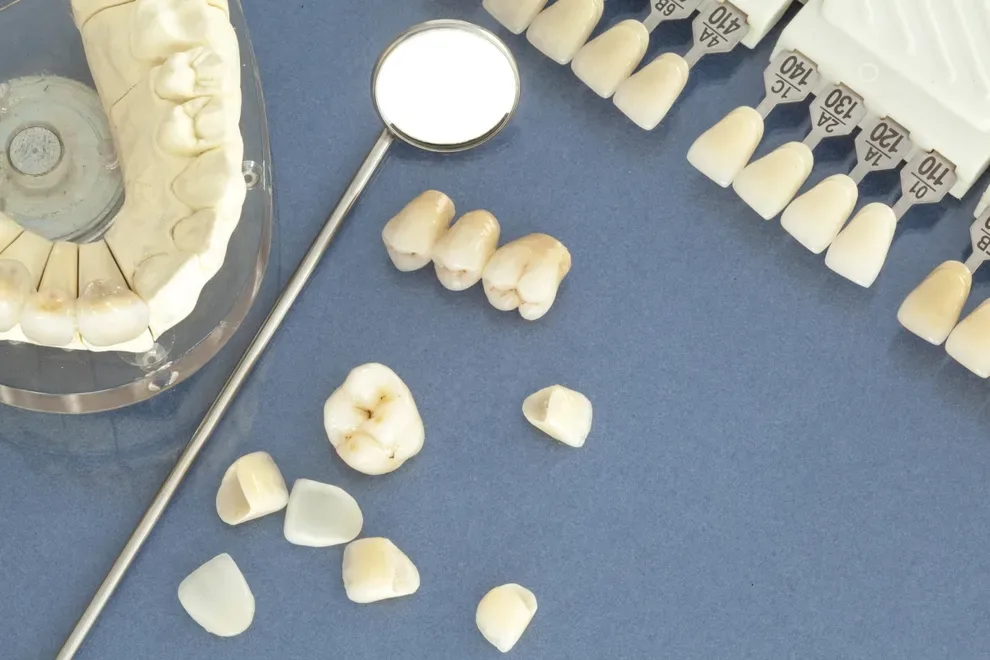
Table of Contents
- Caps vs. Crowns vs. Veneers
- Crowns vs. Veneers: Comparison
- Crowns & Veneers Differences
- Pros & Cons of Crowns
- Pros & Cons of Veneers
- Crowns vs. Veneers Cost
- Cost Overview
- Cosmetic Corrections
- Aligners Make It Easy
- Consult your Dentist
- References
Crowns and veneers typically apply to different underlying dental needs, so your dentist may suggest one versus the other due to issues with your teeth. Generally, crowns are considered necessary since they are used to cover or replace a damaged or missing tooth. Veneers are usually a cosmetic choice.
Since crowns provide a more complete solution, they are usually a bit more expensive than veneers. But crowns may be more likely to be partially covered by dental insurance.
Caps vs. Crowns vs. Veneers
If you’re wondering what the difference is between caps and crowns, you’re not alone. Both terms are commonly used by the general public, especially in older populations.
There is no difference between caps and crowns. They are two terms used for the same thing — a prosthetic that is placed on top of a tooth.
Today, the term crown is much more widely used. When dental professionals speak about these tooth coverings, they use the term crown.
So, there is really not a “caps vs. crowns vs. veneers” debate. There is only a crowns vs. veneers question.
Crowns vs. Veneers: How Do They Compare?
If you have had a root canal or a large filling in a tooth, your dentist will want to put a crown on top of the tooth to protect the dental work and to replicate the shape of your original tooth. You may get a crown over a broken tooth once it is cleaned if your dentist determines there is no need for a filling.
If you need a tooth removed, a crown will be needed to cover an implant that replaces the original tooth. Your dentist may put a crown on one or two teeth to attach a dental bridge, which replaces more than one tooth at a time.
Crowns mimic the appearance and feel of teeth. You may need to see your dentist more often to check on the area and make sure the crown is not wearing away too fast. Since it is synthetic, rather than natural like your permanent teeth, it is more likely to need repairs or replacement over the years. Crowns are designed to last for a long time, however.
Getting a crown may take several visits, depending on what the crown covers. For example, if you need a root canal, you will not get a crown until the area has healed, and your dentist has had time to sculpt the crown to match your original tooth shape.
If you have teeth that are different shapes, too small, or stained, you may pursue veneers as a way to improve your smile.
A veneer is a thin piece of porcelain or resin that is placed on top of your teeth, often your front teeth, to create a natural, healthy appearance. Your dentist will contour the veneer to suit the shape of your teeth after the piece has bonded to your tooth.
Like a crown, getting veneers takes several in-office visits — usually two to three. They can be used to correct small gaps or misalignments in your teeth. For these minor misalignment issues, they can provide a faster solution than straightening teeth with braces.
Resin veneers are inexpensive, but they do not last very long. Porcelain veneers are more expensive, but they last longer — usually between 10 and 20 years.
Veneers may cover fractured, chipped, or cracked teeth, especially in the front. Unlike crowns, they should not be used to cover extensive damage or repair done to teeth. Crowns protect teeth, but veneers are not designed as protection. Instead, they are designed to cosmetically improve your appearance.
Difference between Crowns & Veneers
Crowns and veneers serve different purposes, although both can be used to treat cosmetic issues caused by underlying tooth damage and decay.
They also have different costs, which are based on materials and related issues. They may be partially covered by dental insurance, or you may have to pay entirely out of pocket. Coverage often comes down to why you need the crowns or veneers.
Many people want to improve their smiles, so they investigate crowns or veneers as cosmetic treatment options, but both dental treatments serve different purposes and have different costs.
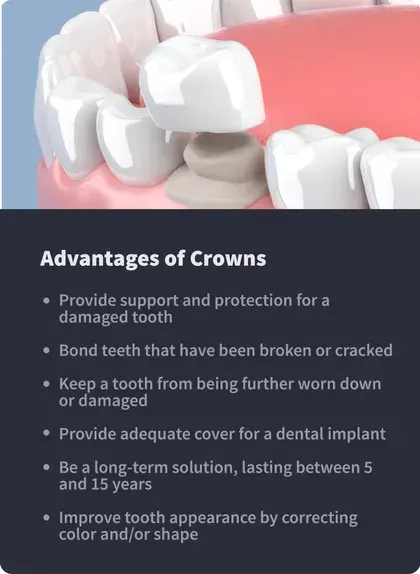
Pros & Cons of Crowns
A crown can be used to cover a tooth that has been damaged or had extensive tooth decay. It can also be used after a root canal procedure.
Crowns have many advantages. They can do the following:
Provide support and protection for a damaged tooth
Bond teeth that have been broken or cracked
Keep a tooth from being further worn down or damaged
Provide adequate cover for a dental implant
Be a long-term solution, lasting between 5 and 15 years
Improve tooth appearance by correcting color and/or shape
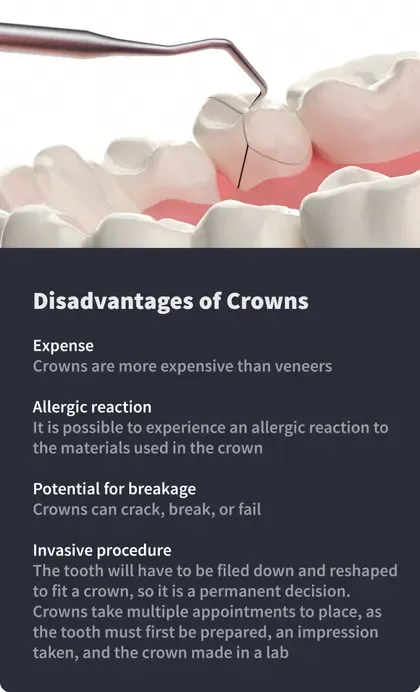
These are potential downsides of crowns:
Expense: Crowns are more expensive than veneers.
Allergic reaction: It is possible to experience an allergic reaction to the materials used in the crown, either the metal or the porcelain.
Potential for breakage: Crowns can crack, break, or fail. As a result, they can end up trapping bacteria underneath them. This can lead to tooth decay in the event that the crown becomes loose and the dental cement washes away.
Invasive procedure: The tooth will have to be filed down and reshaped to fit a crown, so it is a permanent decision. Crowns take multiple appointments to place, as the tooth must first be prepared, and an impression is taken before the crown is made in a lab.
Most of the potential issues with crowns are related to the type of material used and the fit of the crown, which can be addressed with sufficient dental experience and treatment.
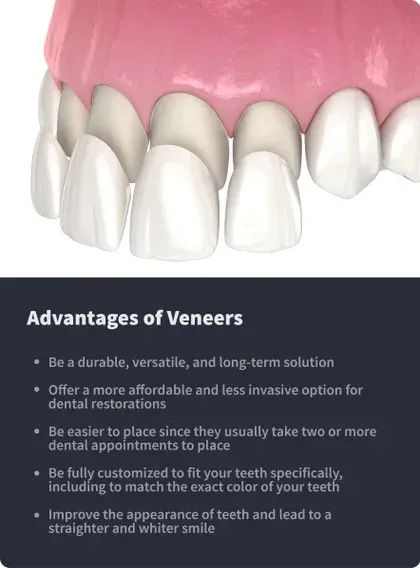
Pros & Cons of Veneers
Veneers can be a good option for minor repairs and imperfections of the teeth. Among their many advantages, veneers can do the following:
Be a durable, versatile, and long-term solution
Offer a more affordable and less invasive option for dental restorations
Be easier to place since they usually take two or more dental appointments to place
Be fully customized to fit your teeth specifically, including to match the exact color of your teeth
Improve the appearance of teeth and lead to a straighter and whiter smile
Overall, veneers offer a quicker and less extreme solution for minor teeth straightening and shaping than braces and other orthodontic treatment methods.
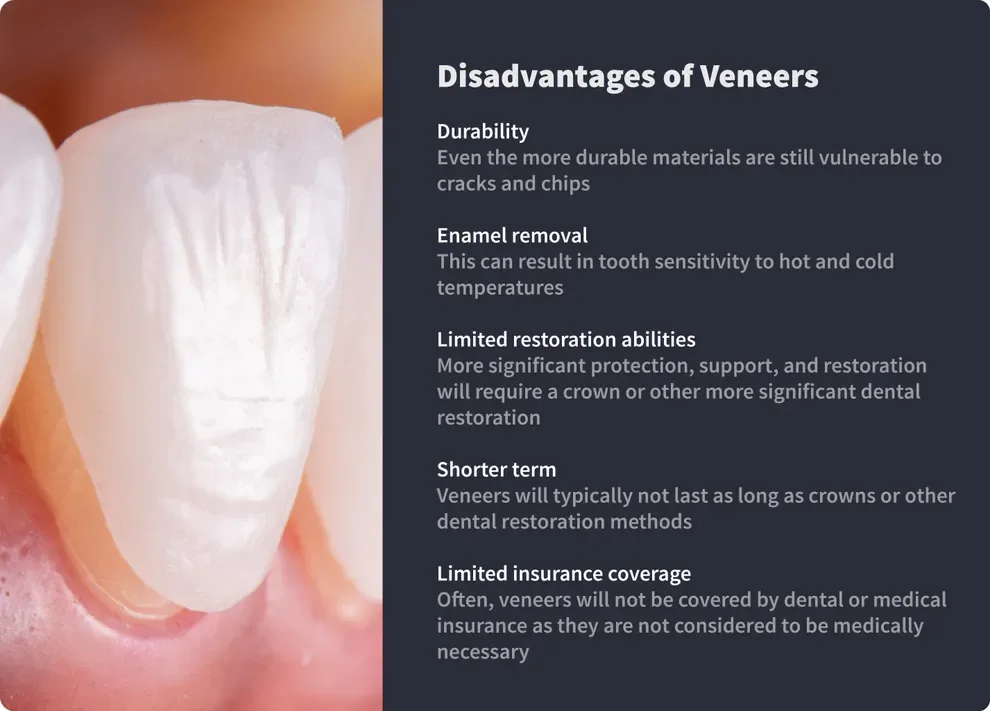
Some potential disadvantages of veneers include the following:
Durability: Veneers’ durability depends on the material used. More durable materials, such as porcelain, will cost more than composite, but composite veneers have more potential to chip, crack, or stain. Even the more durable materials are still vulnerable to cracks and chips.
Enamel removal: Veneers require removing some of the enamel on the tooth to place the veneer, which can result in tooth sensitivity to hot and cold temperatures.
Limited restoration abilities: Unlike crowns, veneers are not designed to restore teeth beyond cosmetic and minor imperfections. More significant protection, support, and restoration will require a crown or other more significant dental restoration.
Shorter term: Veneers will typically not last as long as crowns or other dental restoration methods, with the more durable options being more expensive.
Limited insurance coverage: Often, veneers will not be covered by dental or medical insurance as they are not considered medically necessary. Instead, they are classified as a cosmetic dentistry procedure.
The Cost of Crowns vs. Veneers
Since veneers and crowns apply to different dental needs, they have different costs. They may be covered by dental insurance, but if you get them for cosmetic reasons, you likely need to fully pay out of pocket.
It is important to understand the costs upfront so you can decide which option might work better for you.
If you need a crown, it can cost between $1,000 and $3,500, depending on the material used. Crowns are custom made for you in a separate lab and then delivered to your dentist to be implanted. They can last between 10 and 15 years.
Materials used to make crowns include the following:
Porcelain-infused metal crowns: These crowns are durable and aesthetically pleasing. With wear and tear over time, they may show the underlying metal around the gumline. They cost around $1,000 to $1,400 per crown.
All-porcelain/all-ceramic crowns: These look the most like natural teeth and do not use metal. Their reduced thickness without the metal underlay means they do not last as long. They cost anywhere from $800 to $3,000 per tooth.
Gold: These are not used as often because they do not look like a natural tooth, but they are very durable. Gold crowns may be recommended if you have a strong bite and need the metal support. They can cost about $800 per tooth, but they may sometimes cost $2,000.
There are two basic types of veneers: porcelain veneers and Lumineers or resin veneers. Costs can vary based on these materials, but they typically range from $800 to $2,500 per tooth.
Porcelain lasts 10 to 15 years, while Lumineers may last up to 10 years, depending on how well you care for them and the skill of the dentist placing them.
Other factors that can determine the cost of this procedure include the following:
Fees associated with the cosmetic dentist performing the procedure
Any underlying periodontal work that is required before the veneers are placed
The artistic and technical skill of the ceramic artist who makes the veneers
The location where you receive treatment
The type of dental insurance you have, which may somewhat offset the cost
The number of teeth that will have veneers as well as their size
Cost Overview: Crowns vs. Veneers
| Average cost per tooth | |
|---|---|
| Porcelain-infused metal crown | $1,000–$1,400 |
| All-ceramic or all-porcelain crown | $800–$3,000 |
| Gold crown | $800–$2,000 |
| Composite resin veneers | $800–$1,100 |
| Porcelain | $900–$2,500 |
| Other factors that can increase the cost of crowns or veneers | Exam and x-ray fees Other oral health issues that need to be addressed before the procedure (fillings or gum health) Anesthesia Location of tooth (molars and bicuspids may take longer to work on and cost more than front teeth) A specialist may be more expensive than a general dentist Veneer quality Insurance coverage (most plans do not cover cosmetic procedures) Some cities and regional areas may be more expensive |
Cosmetic Corrections
Crowns are more likely to be applied to medically necessary dental treatments, whereas veneers are more often used to improve the appearance of your smile by making your teeth more uniform.
While veneers can correct some minor alignment issues, such as closing gaps between teeth, it’s generally preferable to straighten your smile via other means. Getting veneers involves grinding down your natural teeth, and it’s better to keep as much of your natural teeth as possible.
Aligners Make It Easy
While braces can straighten teeth well, many people want alternatives because they do not want the embarrassment of metal pieces on their teeth or the expense and time involved in regularly visiting an orthodontist for appointments. As clear aligner treatments have become more popular and easier to access, more people choose this approach to getting a healthy, straight smile.
Most orthodontists and some dentists offer aligner treatment, where patients regularly visit them to pick up new aligner sets. This type of aligner treatment tends to be the most expensive since it still involves regular visits in a dental office. Doctor-monitored, at-home teeth aligners are another option that don’t require any in-person visits.
To start, you make impressions of your teeth at home, which are sent to the aligner company for evaluation. If you are a good candidate for at-home aligners, you’ll have a treatment plan designed for you. A series of clear aligners will then be mailed to you, along with an outlined treatment schedule.
Aligner treatment can fix gaps, crowding, or crooked teeth. It works best for mild to moderate cases. If you have a severe case of dental misalignment, you may need braces. The aligner company will let you know if you aren’t a good candidate for their product.
Veneers only cover very minor misalignment issues. If you are seeking to straighten your teeth, at-home aligners are likely to be a much cheaper and easier option.
Consult your Dentist
If your dentist has recommended crowns, it’s likely you have an underlying dental issue that necessitates them. Crowns are usually used on teeth in the back of the mouth that have been damaged or removed. Veneers are more common on the front teeth to cover cosmetic issues.
Before getting either crowns or veneers, confirm the specific price with your dentist. They can consult your dental insurance provider to see what kind of coverage, if any, they offer for the procedure.
